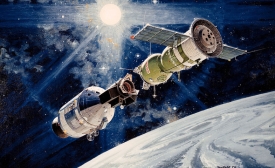richard nixon

Olga Krasnyak looks at Nixon's presidency through the lens of space cooperation with the USSR.
In late spring of 1974, Washington newspapers were crammed with headlines about Watergate and impeachment. But President Nixon was 6,500 miles away in Saudi Arabia, in the middle of an ambitious 10-day, seven-stop foreign trip. His ill-fated mission — derided by critics as "impeachment diplomacy" — holds a lesson for President Trump: While successes in foreign policy can help distract from troubles at home, domestic problems can also spill over into foreign policy and have long-reaching consequences.
It’s called “panda diplomacy” and it’s thought to have started as early as the Tang Dynasty in the 7th century when Empress Wu Zeitan sent a pair of bears (believed to be pandas) to Japan. This Chinese policy of sending pandas as diplomat gifts was revived in 1941, on the eve of the United States entering World War II, when Beijing sent two cuddly black-and-whites to the Bronx Zoo as a “thank you” gift.
President Richard Nixon’s historic 1972 trip to China is being remembered with an exhibit at South Coast Plaza that shows its historic importance and what it did to open the doors of cultural exchange between the countries. [...] The 2,300-square-foot multimedia exhibit features archival photos and videos of the 1972 trip to China, declassified documents, Nixon’s yellow writing pads and a video that tells the story of how Nixon was able to open communications with China.
Forty-five years ago, Cold War tensions between the United States and communist China were lessened thanks to an unlikely diplomatic tool: ping-pong. On April 10, 1971, the U.S. table tennis team arrived in China for a 10-day visit, becoming the first group of Americans in over 20 years to get a peek behind the “Bamboo Curtain.”
In 2009, the author and food historian Andrew Coe published the book Chop Suey: A Cultural History of Chinese Food in the United States. From the first Americans to travel to China in 1784 through widespread anti-Chinese sentiment in the 19th century, Coe traced how it took the United States quite some time to develop a taste for Chinese cuisine.
The first official visit since the 1950s to what was then a closed, even secretive Communist country, the tournament remembered as “Ping-Pong diplomacy” changed the course of history. It broke China’s deeply hostile relationship with the United States, and led to the momentous visit by President Richard Nixon the following year.
Two musk oxen for a pair of giant pandas. Who would make that trade? The Chinese did, when President Richard M. Nixon was on his world-changing trip to China in 1972. [...] Panda diplomacy has had a long history, but before Ling-Ling and Hsing-Hsing arrived in the United States (not long after Nixon returned from his trip), there hadn’t been a giant panda here for more than 20 years.







